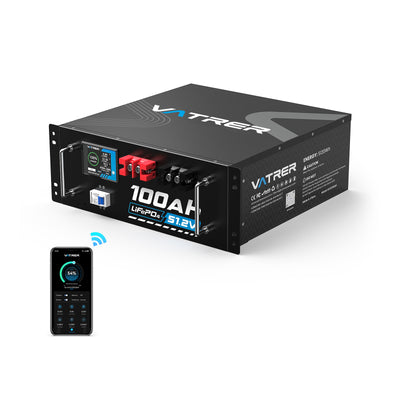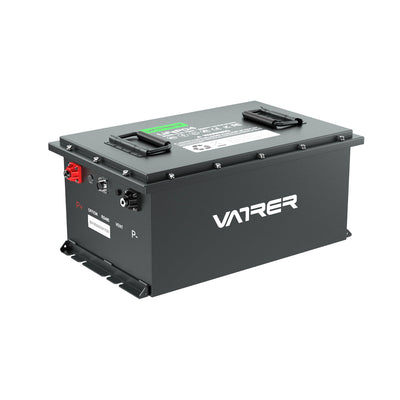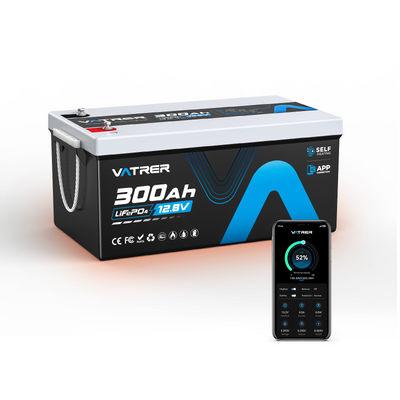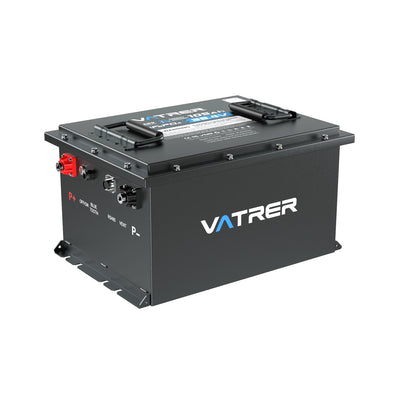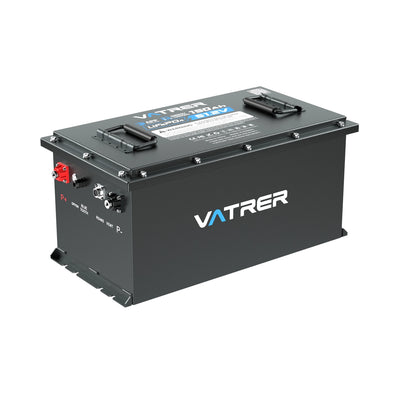
What Is The Best Deep Cycle Battery For a RV
Picture yourself on a remote backcountry campsite, leaving your RV’s air conditioner running through the night or keeping your fridge cold 24/7 without giving the power supply a second thought. That kind of freedom depends on having the right deep cycle RV battery in place, supplying consistent energy for your lights, appliances, and electronics even when you are completely off the grid.
Deep cycle batteries are designed to deliver a steady flow of power over long periods, which makes them essential for dry camping. With lithium deep cycle RV batteries becoming more common thanks to their efficiency and long service life, this in-depth guide will help you choose the best RV deep cycle battery for the way you travel, so you can stay comfortable and powered up on every trip.

What Are Deep Cycle Batteries for RV Camping?
Think of a deep cycle RV battery as a long-distance runner that keeps your RV systems going hour after hour, instead of a starting battery that delivers a quick burst of energy like a sprinter.
These batteries can safely tolerate deep discharges of about 80%-100% of their capacity without being damaged. That makes them well suited to running higher draw devices such as microwaves, CPAP machines, or air conditioners during longer stays off-grid.
Understanding the differences between LiFePO4, AGM, gel, flooded lead-acid, and hybrid deep cycle marine and RV batteries helps you choose a battery that matches how you use your RV and keeps your power reliable for both weekend trips and longer getaways.
For more detail on deep cycle batteries, you can continue reading:
What is a group 24 deep cycle battery?
Exploring Types of Deep Cycle RV Batteries
To decide on the best RV deep cycle battery, it helps to understand the pros and cons of each technology. Below, we outline the main battery types and how they perform in real-world RV camping.
Lithium Iron Phosphate (LiFePO4)
LiFePO4 deep cycle batteries are a top pick among RV owners, acting like a dependable partner that can run everything from medical devices to induction cooktops during off-grid stays. They support very fast charging (often up to five times quicker than AGM), weigh significantly less (about 30-50% lighter than lead-acid), and can be discharged fully without harm. With an expected life of roughly 2,000-5,000 cycles, they clearly outperform most other RV battery types. Their stable chemistry enhances safety in compact RV interiors, and they are more environmentally responsible, free from toxic heavy metals and aligned with RoHS requirements.
Absorbed Glass Mat (AGM)
AGM deep-cycle RV batteries are like sturdy off-road trucks, built to cope with vibration and harsh weather, including below-freezing temperatures. They are sealed, maintenance-free, and spill-proof, and they can usually be discharged down to about 80%, which works well for shorter off-grid trips. However, their cycle life (around 500-1,000 cycles) is less than LiFePO4, and they need careful charging management to avoid premature ageing from overcharging.
If you are considering AGM batteries, you can learn more here: what is an AGM battery?
Gel Battery
Gel batteries rely on a gelled electrolyte, somewhat like a sealed container that reduces the risk of spills and gas emissions compared with traditional flooded lead-acid batteries. They are maintenance-free and can offer good charge efficiency, but they need a specific “low and slow” charging profile to avoid internal damage. Because of these strict charging requirements and their more limited availability, they tend to be less convenient for most RV owners than AGM or LiFePO4 options.
Flooded Lead-Acid
Flooded lead-acid batteries are the classic budget option, but they are heavy and require regular attention. They can overheat if misused, need monthly top-ups of electrolyte, and release hydrogen gas when charging, which must be vented safely. They should be stored fully charged in cold conditions to prevent freezing, and they are generally limited to about 50% depth of discharge, with a typical lifespan of 300-500 cycles. All of this makes them less suitable for frequent deep cycling in RV applications.
Marine and RV Batteries
Deep cycle marine and RV batteries, often sold in group 24 deep cycle RV battery or group 27 sizes, are hybrid designs that combine some starting and some deep cycle capability. They are economical but not as robust as dedicated deep cycle batteries. They can work well in RVs that spend most of their time on hookups at campgrounds, as long as they have enough reserve capacity and are discharged at a modest rate.
The table below highlights the main differences between RV battery types and can help you narrow down the best match for your RV’s electrical system and your camping habits.
| Battery Type | Lifespan (Cycles) | Maintenance | Discharge Depth | Weight | Best For |
|---|---|---|---|---|---|
| LiFePO4 | 2,000-5,000 | None | 100% | Light | Boondocking, long-term use |
| AGM | 500-1,000 | None | 80% | Moderate | Short trips, vibration-heavy routes |
| Gel | 500-800 | None | 50-80% | Moderate | Stable environments, careful charging |
| Flooded Lead-Acid | 300-500 | High | 50% | Heavy | Budget-conscious, campground use |
Why LiFePO4 Deep Cycle Batteries Best for RV Camping
The lighter construction of lithium batteries helps improve fuel efficiency for the RV and makes installation and handling easier. Integrated Battery Management Systems (BMS) protect against issues such as overcharging, overheating, and short circuits, which is particularly important in compact RV interiors. LiFePO4 batteries are also more environmentally considerate, reducing hazardous waste and supporting low-impact camping—an attractive benefit for RVers in Canada who value sustainable travel.
Although the upfront purchase cost is higher, the long service life and reduced maintenance can lower total ownership costs over time, especially with lifespans in the 5-10 year range. For RV owners who want dependable power on dry camping trips, lithium deep cycle RV batteries are often the most effective solution.
How to Choose the Best Deep Cycle Battery for Your RV
Selecting the best RV deep cycle battery means balancing how much power you use with practical considerations like weight, space, and budget. Here are the main factors to review:
- Capacity (Amp-Hours, Ah): Capacity, measured in amp hours (Ah), determines how long your battery can run your loads. A 12 volt deep cycle RV battery in the 100-200 Ah range is suitable for boondocking, while a group 24 deep cycle RV battery (around 70-85 Ah) is better suited to lighter use or shorter trips.
- Depth of Discharge (DoD): LiFePO4 batteries can comfortably be discharged to nearly 100% of their rating, while lead-acid options such as AGM deep cycle RV batteries should ideally be limited to around 50% to preserve lifespan.
- Voltage: The majority of RVs in North America use 12V RV battery deep cycle systems, though some owners connect 6 volt deep cycle RV batteries in series to create a 12V bank for higher power demands.
- Charging Compatibility: Confirm that your chosen battery works with your solar panels, inverter/charger, generator, and shore power setup. LiFePO4 batteries handle fast charging well, especially when charged through solar or the vehicle alternator.
- Temperature Tolerance: RV batteries must withstand temperature swings, humidity, and in some parts of Canada, winter conditions. LiFePO4 and AGM batteries typically perform well here, and certain LiFePO4 models also include low-temperature cut-off or self-heating functions. Batteries like the Vatrer RV battery, with low-temperature protection, Bluetooth connectivity, and self-heating, are designed for year-round camping in a wide range of climates.
- Vibration Resistance: RV travel involves bumps, rough roads, and vibration. AGM and LiFePO4 batteries handle these conditions well. Vatrer batteries also meet IP65 standards, adding dust and water resistance for extra durability.
- Size and Weight: Compact, lightweight batteries such as LiFePO4 free up storage space and reduce the overall weight of the RV, which can be an advantage on long drives or in smaller units.
- Warranty and Support: LiFePO4 batteries commonly include longer warranty periods of about 5–10 years, compared with 1-3 years for many AGM or flooded batteries, reflecting their better durability. Look for brands with dependable customer service, such as Vatrer battery, especially if you travel extensively.
Cost-Benefit Analysis: LiFePO4 vs. Other RV Deep Cycle Batteries
A 100Ah lithium deep cycle RV battery will generally cost in the range of $600-$1,200, compared with about $25-$450 for a similar AGM deep cycle RV battery or roughly $100-$300 for a flooded lead-acid model.
Although LiFePO4 has the highest initial cost, its 5,000+ potential cycles work out to around $0.20 per cycle, while AGM batteries (around 800 cycles) average about $0.38, and lead-acid (about 500 cycles) can be closer to $0.60 per cycle.
Standard lead-acid batteries may also need dedicated ventilation and additional hardware to be installed safely inside an RV, which adds further expense. For Canadians who travel regularly or full-time, the low-maintenance operation and extended life of LiFePO4 can result in significant long-term savings.
Top Best Deep Cycle Battery Recommendations for RVs
Choosing the right deep cycle RV battery ensures that all your on-board systems—from LED lights and water pumps through to air conditioners—run smoothly while you are on the road or at a remote site.
Vatrer lithium deep cycle RV batteries provide stable, long-lasting power and advanced features like Bluetooth monitoring and self-heating, making them suitable for a wide range of RV camping conditions.
Below are five recommended Vatrer models designed with RV use in mind, covering different layouts, power needs, and camping styles.
Before ordering, always measure your RV’s battery compartment and confirm your cabling and mounting so the new battery—especially a group 24 deep cycle RV battery—fits properly.
- Vatrer 12V 100Ah Group 24 Battery: A solid option for compact RV systems or weekend travellers, this 12V RV battery deep cycle unit provides 1,280Wh of energy and weighs only 23.14 lbs. Its 100A BMS supports common loads such as LED lighting, fans, and 12V fridges. It is ideal for Class B RVs, van conversions, and other layouts where space is limited.
- Vatrer 12V 100Ah LiFePO4 Heated Battery: Designed for cold-weather camping, this LiFePO4 deep cycle battery includes low-temperature cut-off protection, stopping charging below 32°F (0°C) to prevent damage. With 1,280Wh of capacity and a 100A BMS, it can power critical loads such as CPAP machines or compact heaters, and Bluetooth connectivity lets you monitor status through the Vatrer app. At 24.20 lbs, it suits RVers who spend time in northern or shoulder-season conditions.
- Vatrer 12V 200Ah Plus Lithium Battery: A flexible choice for mid-sized RVs, this deep cycle RV battery provides 2,560Wh of energy and uses a 200A BMS, making it capable of running larger appliances like microwaves or a rooftop air conditioner. Its low-temperature protection and 48.5 lbs weight make it appealing for Class C RVs or frequent boondockers who need reliable power for longer stays away from hookups.
- Vatrer 12V 460Ah Deep Cycle Lithium RV Battery: Built for high-demand electrical systems, this lithium deep cycle RV battery delivers 5,888Wh and includes a 250A BMS, making it suitable for large Class A motorhomes or fifth wheels running several major appliances at once. Bluetooth monitoring allows real-time tracking, and the 3,200W power output can handle heavy loads like induction cooktops. At 104.7 lbs, it can replace multiple lead-acid batteries with a single compact unit.
- Vatrer 12V 560Ah Self-Heating Lithium RV Battery: A premium option for extended and luxury RV camping, this deep cycle RV battery offers 7,168Wh of capacity with a 300A BMS, supporting fully off-grid setups running air conditioners, fridges, and more. Self-heating and Bluetooth features ensure reliable performance in harsh conditions, and with a cycle life of 5,000+ cycles, it is well suited to full-time RV life. At 136.58 lbs, it is engineered for larger battery compartments in high-end RVs.
These Vatrer LiFePO4 deep cycle batteries support different RV camping styles, from occasional weekend trips to full-time boondocking. Their lighter weight, quick-charging capability, and IP65-rated protection make them an excellent fit for dry camping and remote travel, helping you stay powered wherever your route leads.
How BMS Enhances LiFePO4 Deep Cycle Batteries for RVs
A Battery Management System (BMS) functions like a built-in safety monitor for LiFePO4 deep cycle batteries, continuously tracking voltage, current, and temperature to protect against overcharging, excessive discharge, overheating, or short circuits.
This active protection helps ensure safe, predictable performance in an RV, reducing the risk of sudden power loss that could shut down key appliances while you are in a remote area.
Many LiFePO4 batteries, including leading models from Vatrer, now include Bluetooth-enabled BMS technology, so you can check battery status and history on a smartphone app. This real-time visibility makes it easier for RVers to manage power usage and plan charging, especially on longer trips.
Solar and Inverter Compatibility for RV Deep Cycle Batteries
A lot of RV owners rely on solar panels to recharge their batteries when away from shore power, and LiFePO4 deep cycle batteries pair well with solar because they accept higher charge rates.
A 200-400W solar array, under good sun conditions, can typically recharge a 100Ah LiFePO4 battery in roughly 4-8 hours. Using an MPPT (Maximum Power Point Tracking) solar charge controller helps maximise efficiency; PWM controllers may not perform as well with LiFePO4 systems.
LiFePO4 batteries also support higher discharge rates, making them well suited to running inverters that power AC appliances like air conditioners, microwaves, or kettles. Always verify that your inverter/charger and solar controller are configured and rated for LiFePO4 batteries for the best overall performance.
Maintenance Tips for Your Deep Cycle RV Battery's Longevity
Looking after your deep cycle RV battery properly can significantly extend its service life:
- LiFePO4: Essentially maintenance-free. Store the battery charged (or at the manufacturer’s recommended level) in moderate temperatures, and use the BMS app to keep an eye on state of charge and operating conditions.
- AGM/Gel: Also maintenance-free. Avoid chronic overcharging, and store them in a cool, dry place when not in use.
- Flooded Lead-Acid: Inspect electrolyte levels monthly, top up with distilled water as needed, and keep terminals clean by removing corrosion with a baking soda solution. For safety, disconnect the negative terminal first. If these batteries are left undercharged, sulfation can occur, forming crystals on the plates that permanently reduce capacity and lifespan.
Tips: Lead-acid batteries should be recharged to 100% after being discharged to around 50% to keep sulfation in check. For deep-cycle lithium battery systems, using a digital voltmeter or dedicated battery monitor helps you track charge levels accurately in real time.
Conclusion
For most RV owners in Canada, a LiFePO4 deep cycle battery stands out as the best overall choice because of its long lifespan, safety features, and low weight—ideal for dry camping and extended off-grid trips.
AGM deep cycle RV batteries can be a good option for those watching their budget or who mostly stay on serviced campsites, while traditional flooded lead-acid batteries are becoming less practical due to their higher maintenance requirements and shorter life.
Consider how often you camp, the type of trips you take, and your typical power demands, then choose a battery that will genuinely improve your RV experience.
Not sure where to start with sizing? Vatrer's online calculator can help you work out a tailored solution for your RV power needs!
Share


































